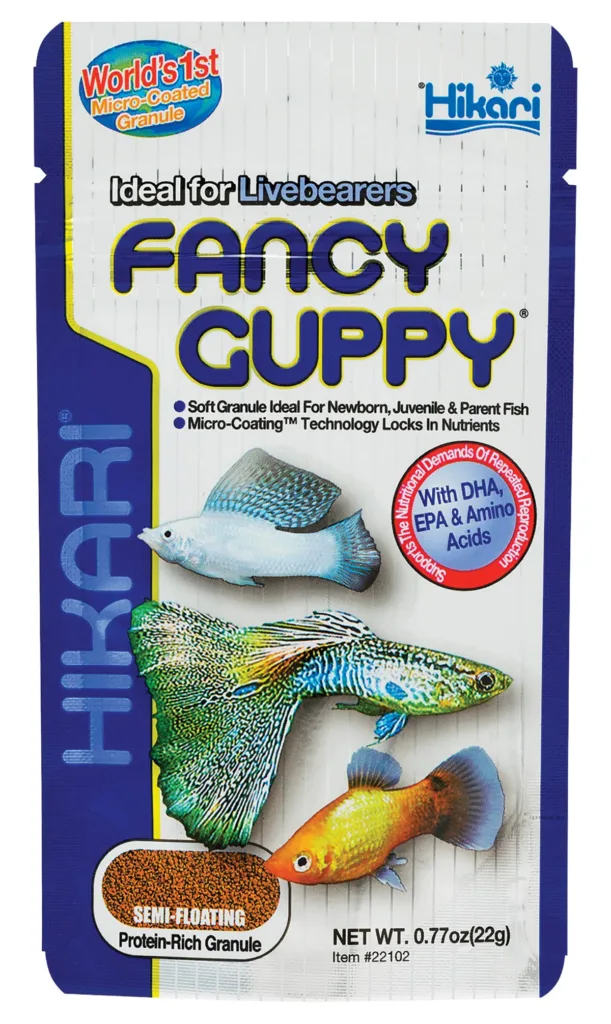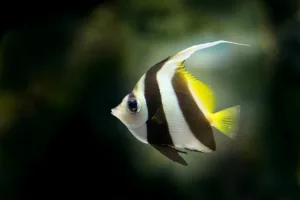Albino guppy are a beautiful and unique variety of guppy that lack the melanin pigment that gives other guppies their color. This results in a fish with a white or pale yellow body and red eyes. Albino guppies can be found in a variety of colors, including red, blue, and yellow. In this albino guppy care guide we will cover breeding, feeding, tanksize, albino guppy male, and albino guppy female.
What is an albino Guppy?
An Albino Guppy is a variation of the common guppy (Poecilia reticulata) that displays a unique and distinctive genetic trait known as albinism. This trait results in the absence of melanin, the pigment responsible for coloration in most fish. The term “albino” is commonly used to describe individuals, whether human or animal, who lack melanin, and it typically refers to organisms with white or pale bodies and red or pink eyes. Albino Guppies, therefore, have a nearly translucent, white or pale body and distinctive red or pink eyes.
Appearance of Albino Guppies

Albino Guppies are a striking variation of the common guppy (Poecilia reticulata). Their most defining characteristic is their vibrant, nearly translucent body, which is devoid of melanin, the pigment responsible for coloration in most fish. Let’s delve deeper into their appearance:
1. Coloration and Pigmentation
- Albino Guppies are entirely devoid of pigmentation. Their bodies are typically pale white, almost transparent, which makes them distinct from their non-albino counterparts.
- You can easily identify Albino Guppies by their distinctive red or pink eyes, a trait typical of albino fish across various species.
2. Fins and Tail
- The fins of Albino Guppies are also transparent but may have a slightly pinkish hue.
- Their tail fin, often referred to as the caudal fin, can vary in shape, from round to fan-shaped, and may display a subtle touch of color or patterns.
3. Size and Shape
- Albino Guppies are relatively small, with adult males typically growing to about 1 to 1.5 inches in length, while females are slightly larger, reaching up to 2 inches.
- These fish have a slender and elongated body, well-suited for swift, graceful swimming.
Different varieties of albino guppies
Albino Guppies, like their non-albino counterparts, come in various strains, each characterized by unique color patterns and features. These strains have been developed through selective breeding. While the common feature among all Albino Guppies is their lack of melanin, you can find several distinct variations, each with its specific aesthetic appeal. Here are some different types of Albino Guppies:
- Albino Red Guppy: Albino Red Guppies typically have a translucent white body and striking red or pink eyes. Some strains may have red or orange accents on their fins, creating a visually pleasing contrast.
- Albino Blue Guppy: Albino Blue Guppies have the classic albino characteristics of a white body and pink eyes but may exhibit subtle blue or iridescent hues on their fins and tails.
- Albino Yellow Guppy: Albino Yellow Guppies are recognized for their white bodies and vibrant yellow or gold-colored fins, giving them a sunny and cheerful appearance.
- Albino Green Guppy: While less common, Albino Green Guppies may feature a light green tint in their fins, which contrasts beautifully with their albino body.
- Albino Cobra Guppy: This strain has a unique pattern that resembles the scales of a cobra snake. They combine the albino traits with distinctive, serpentine-like markings on their bodies.
- Albino Leopard Guppy: These Guppies feature speckled patterns that resemble the spots of a leopard. The spots are often black, creating a bold contrast against their pale bodies.
- Albino Moscow Guppy: Moscow Guppies, which are known for their distinctive shape and large, fan-shaped tails, can also be found in the albino variation, creating an elegant and visually striking fish.
- Albino Koi Guppy: Albino Koi Guppies resemble the famous Koi carp with their red, white, and black coloration. They feature a striking pattern reminiscent of Koi fish.
- Albino Snakeskin Guppy: Snakeskin Guppies have a distinct pattern that resembles snake scales. Albino Snakeskin Guppies combine this pattern with the albino traits.
- Albino Tuxedo Guppy: These Guppies have a tuxedo-like appearance with darker coloration primarily on their tails, giving them a formal and stylish look.
Origin and History
To understand the Albino Guppy’s origins, we must first delve into the history of the guppy itself. The guppy is native to South America, particularly Venezuela and Trinidad. It was initially discovered in the mid-19th century, and its name honors Robert John Lechmere Guppy, who was an avid naturalist. The Albino Guppy, being a color morph of the guppy, likely emerged through selective breeding for specific traits.
Albinism is a genetic condition that results in a lack of pigmentation. Albino fish are relatively common in the aquarium trade, and their genetic trait is typically inherited as a simple recessive gene. This trait became popular due to the captivating contrast of the white body and red or pink eyes.
Setting Up the Perfect Tank for Albino Guppies
1. Tank Size
- The best tank size for albino guppy is 10 plus gallons. These fish are well-suited for community tanks and can coexist peacefully with various other species.
2. Water Parameters
- Albino Guppies prefer slightly alkaline water with a pH range of 7.0 to 7.8.
- Maintain a water temperature of 75-82°F (24-28°C) to keep your fish comfortable.
3. Filtration and Aeration
- Ensure efficient filtration to maintain water quality and circulation. Guppies appreciate a gentle current.
- Aeration is crucial to oxygenate the water, which is especially vital in densely populated tanks.
4. Aquarium Decor
- Albino Guppies will appreciate plenty of live or artificial plants for hiding and exploring.
- Substrates like fine gravel or sand are suitable for the tank bottom.
5. Lighting
- Guppies, including Albino Guppies, enjoy well-lit tanks. Use a timer to provide consistent lighting for around 10-12 hours a day.
6. Cover
- Albino Guppies are jumpers, so it’s essential to have a secure lid on your tank to prevent them from leaping out.
Breeding Albino Guppies
Breeding Albino Guppies can be a rewarding experience, as these fish are known for their prolific reproduction. Let’s explore the essentials of breeding these beautiful fish:
1. Sex Differentiation
- Distinguishing between male and female Albino Guppies is relatively straightforward. Males are smaller, slimmer, and display vibrant colors, while females are larger with a more rounded appearance.
2. Breeding Tank
- Consider setting up a separate breeding tank with plants or breeding traps to protect fry (baby fish) from adult fish who may view them as a snack.
3. Courtship and Mating
- Males will often display their vivid colors and “dance” around the females to court them. After successful courtship, mating occurs. Guppies are livebearers, which means they give birth to live fry instead of laying eggs.
4. Gestation and Birth
- The gestation period of Albino Guppies is typically around 21-30 days. Once the female is ready to give birth, she will release fry into the water. These fry are tiny and may require a special nursery tank for their protection and growth.
5. Feeding Fry
- Newborn fry are incredibly small and should be fed appropriately-sized food, like powdered fish flakes or specially formulated fry food. Gradually, they will grow and develop their vibrant colors.
Feeding Albino Guppies

Maintaining a well-balanced diet is essential for the health and vibrancy of Albino Guppies. These fish are omnivorous and relatively easy to feed, but it’s important to offer a variety of foods to meet their nutritional needs:
1. Commercial Fish Flakes
- High-quality commercial fish flakes form the staple of an Albino Guppy’s diet. Look for flakes designed for tropical fish.
2. Live and Frozen Foods
- Albino Guppies will relish live or frozen foods like brine shrimp, daphnia, and bloodworms. These options provide essential protein.
3. Vegetable Matter
- Include vegetable matter in their diet. You can feed them blanched spinach, zucchini, or even spirulina-based flakes.
4. Feeding Frequency
- Feed your Albino Guppies small portions 2-3 times a day, only what they can consume within 2-3 minutes. Overfeeding can lead to health issues and water quality problems.
Maintaining a balanced diet will enhance their coloration and overall health.
Common Diseases and Health Maintenance
Like all aquarium fish, Albino Guppies are susceptible to specific diseases. Being aware of these issues and taking preventive measures can help ensure the well-being of your fish:
1. Ich (White Spot Disease)
- This common parasitic infection presents as white cysts on the fish’s skin and gills. Maintain good water quality, avoid stress, and use commercial treatments if needed.
2. Fin Rot
- Poor water quality and stress can lead to fin rot. Ensure clean water, good filtration, and treat affected fish promptly.
3. Dropsy
- Dropsy is a severe condition characterized by swelling and pineconing of the scales. It may indicate various underlying issues. Quarantine affected fish and consult a veterinarian if possible.
4. Internal Parasites
- Some internal parasites can affect Albino Guppies. Watch for signs of weight loss and treat with appropriate medications.
5. Stress Prevention
- Maintain stable water conditions, avoid overcrowding, and provide adequate hiding places to reduce stress.
6. Quarantine New Fish
- Before introducing new fish to your aquarium, quarantine them for a few weeks to ensure they are disease-free.
4. Lifespan
- Albino Guppies typically have a lifespan of 2 to 3 years, though with proper care, some can live longer.
Albino Guppy Tank Mates
Guppies are known for their peaceful nature, making them excellent tank mates for various other fish species in a community aquarium. When choosing tank mates for guppies, it’s How to Set Up a Guppy Fish Tank: The 10 Step Guide for Beginners on setting up a guppy fish tank essential to consider their peaceful temperament, water parameter compatibility, and similar dietary requirements. Here are some other types of fish that typically make good tank mates for guppies:
Remember that even within peaceful species, individual personalities can vary. When introducing new fish to your aquarium, monitor their interactions and be prepared to separate any overly aggressive individuals. How to Set Up a Guppy Fish Tank: The 10 Step Guide for Beginners on setting up a guppy fish tank Additionally, make sure your tank size is suitable for the number of fish and that you provide adequate hiding places and plants to reduce stress and promote harmony among tank mates.










